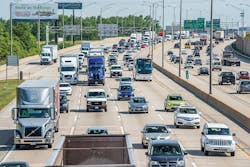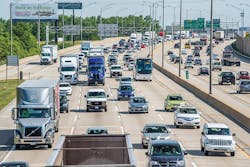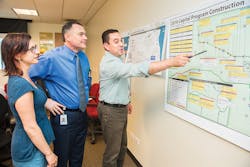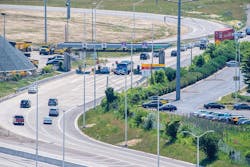By: Suze Parker
In recent years, the Illinois Tollway has undertaken a massive capital improvement program designed to improve mobility, relieve congestion and reduce pollution in the state. The Tollway’s congestion–relief program, Open Roads for a Faster Future, initiated in 2004, enabled rebuilding and restoration of nearly the entire Tollway system and converted mainline toll plazas to barrier-free open-road tolling.
On the heels of that successful program, the Tollway in 2011 approved a 15-year, $14 billion capital program, Move Illinois. The program, which addresses additional system needs, entails building or rebuilding numerous bridges and interchanges, and widening miles of roadway to address congestion, safety, technology and to ensure the system remains in a state of good repair.
A centerpiece of the program has been the rebuilding and widening of the Jane Addams Memorial Tollway (I-90) as a state-of-the-art corridor. As a “smart road,” the I-90 section uses wireless speed sensors, weather stations and dozens of cameras to collect data and transmit it to the Tollway Information Management center. There, a traffic team analyzes the data and updates digital information signs along the roadway in real time. The early alert of crashes and closed lanes give drivers time to merge into open lanes, reducing delays and improving traffic flow.
Mega capital programs like Move Illinois deliver greater safety and mobility for motorists. Their sheer size and complexity also present myriad challenges for toll authorities and their program partners.
The Illinois Tollway already was using a construction management software product to manage Move Illinois’ design phase work, review of design milestones and field work, but that product provided fewer capabilities than the program’s massive scope demanded. The Tollway and its program management consultant, HNTB, believed another product might offer greater breadth and flexibility.
“The Illinois Tollway unbundles contracts,” said Greg Bedalov, the agency’s executive director. “We might break 15 miles of roadway into three 5-mile contracts. With three contractors, when each contract affects the others, we must manage the projects seamlessly. We wanted a system that could automate workflows and provide transparency for an enormous number of individual vendor transactions.”
The Jane Addams Memorial Tollway has been reconstructed as a “smart road.”
Selecting a web-based system
Believing a highly configurable, off-the-shelf solution could work as the system of record for the mega program, HNTB evaluated possible web-based construction management tools that would enable comprehensive administration of the program’s engineering aspects. HNTB met with Tollway department heads, staff members, designers and other stakeholders who would need to interact with the software, using information gleaned from those meetings to develop a detailed set of RFP requirements.
“Virtually every system vendor will say their technology can do what you want, so it’s critical to understand fully what the software needs to deliver,” said Chris Hoagland, HNTB associate vice president. “Meetings with key Tollway personnel allowed us to tease out what the system needed to do. That front-end work was critical to identifying the requirements and writing the RFP so respondents could be measured against their ability to meet the identified needs.”
Potential systems were scored based on their cost-effectiveness and ability to meet wide-ranging imperatives. Among other goals, planners looked for a new system that could provide cost and contracts management. Paul Kovacs, P.E., the Tollway’s chief engineering officer, said the team also sought a tool that would operate on a “ball-in-court” basis.
“A system that would track how an item moves through the program would help keep people on task and make everyone aware they need to respond in a timely fashion,” Kovacs said.
The team ultimately settled on e-Builder, a software that combines capital planning, integrated cost management and controls, process automation, robust reports and dashboards, scheduling, and bid and document management.
The I-90 reconstruction included a new, expanded Fox River Bridge.
Support for a mega capital program
With more than 900 firms involved in the Move Illinois program, having a broadly capable construction management platform has given designers the ability to streamline and organize in a constantly changing, sometimes hectic environment. The system ensures data integrity and provides unlimited licenses that allow access to more than 2,000 users, making consistent information available from a single source.
More than 70 processes, including right-of-way acquisition, utility management, project management and costs and contracts, are automated within the system, with more to come. The software holds records for 440 ongoing projects.
“Information sharing and approvals happen more quickly because users have 24/7 access to the system, whether they’re in the office, in the field or at home,” Hoagland said. “People no longer have to be dependent on others for the information they need. They can easily find the data themselves, and they receive action item due dates to keep things moving smoothly.”
Reporting is automated, allowing users to subscribe to the reports they need and to assign the frequency of report delivery. Automation also has sped up processes. For example, contractors regularly add new subs to the capital program under the Tollway’s A15 subcontractor approval system. Since that process was added to the construction management software, approvals that previously required two to three weeks now take place in a matter of hours.
Supporting the Tollway’s goal to go paperless by 2019, the system has minimized the massive volume of paper typical in a mega capital program. Far fewer man-hours are required to physically route hard-copy documents to multiple reviewers. Professional services invoicing alone, now managed through the web-based platform, has eliminated invoices that were sometimes 6 in. thick. The Tollway already has seen a seven-figure improvement in paper savings.
The software allows the Tollway to remain nimble, with new processes added regularly based on freshly identified needs. When a construction site accident led to the Tollway’s request for a more structured review of demolition and erection plans, for instance, those who needed to have input met quickly, and the newly minted process was developed, set up in the system, tested and rolled out within 48 hours.
“We’ve endeavored to have everything work in a single system that becomes the project record in all ways,” said HNTB Vice President Chris Arman. “Integrated reporting mixes financials, field information and process data. Users can quickly drill down into the detail they need—for instance, from the contract down to the correspondence related to it.”
Among the greatest benefits to the Tollway is the automation of release of retainage, Bedalov said.
“We retain certain money on every vendor contract until we inspect their work and ensure it meets our standards,” he said. “When the inspection is done, we release the retainage. This process previously required full review by the Tollway board of directors. I can now review the documentation through the system and approve it with one click. Speeding up release of retainage increases cash flow to the vendor community. That helps subcontractors and DBEs get paid faster. When they can run more efficient businesses, we get more competitive pricing.”
Tollway officials credit a new management system with introducing efficiencies and savings into ops and planning.
An intuitive, flexible system
The system in place previously was not popular with Tollway personnel or its project partners, so prospective users were cynical about any platform’s potential to become a more useful resource. HNTB fast-tracked rollout of the new system’s implementation, intentionally replacing the functionality of the old tool first to help users become comfortable with the processes they already knew. A dozen processes were live within just five weeks.
Users quickly recognized that a web-based system chosen to fit the program’s needs could be an effective tool, Hoagland said. With that understanding, they became very receptive to the addition of new processes they had not used before.
“Users now come to us with ideas for processes we haven’t even thought about,” she said.
Without restriction, every organization with a role on the Tollway, including contractors and subcontractors, is welcome on the system. HNTB maintains the system with a three-person team that provides in-house training and support to answer questions and provide repeat training as needed.
No off-the-shelf tool will provide every function a massive capital program needs, but Arman said steps have been taken to make the Tollway’s new system fit Move Illinois’ enormous requirements as much as possible.
“Any off-the-shelf solution will have limits,” he said. “We have implemented some work-arounds and addressed some limitations through customization, particularly in cost functionality. We also undertook an enterprise resource planning system integration that focused on changing the Tollway’s business processes to better use the tool.”
Best practices ensure system effectiveness
“Often, when people choose an off-the-shelf system, they only implement portions of it,” Arman said. “But using all available capabilities and making the platform the primary operating tool for all activity on a capital program means you’ll be more efficient and more integrated.”
Illinois Tollway and HNTB leaders offer these best practices for other toll agency executives and staff who may want to consider how a web-based system might help them manage mega capital programs:
- Clarify the system needs up front. Before issuing an RFP, engage internal staff, consultants, contractors and other stakeholders in helping broadly identify issues the system needs to address. Giving stakeholders a voice in how the system will be set up not only ensures a better end product, but also gives them ownership that enhances adoption when the system rolls out;
- Look beyond the cheapest solution. Cost shouldn’t be the most important factor in your selection. Choosing on cost alone ignores all the work you have done to identify what you really need;
- Leadership support is critical. Users’ commitment to learning and using a web-based tool will be higher when agency executives communicate their commitment to the system. Illinois Tollway leaders are “100% committed, and staff knows compliance is mandatory,” Bedalov said. “Staff has taken that mindset to the contractor community and insisted on their compliance as well.”;
- Be prepared to adjust business practices. To make the selected system as effective as possible, relentlessly review internal processes and be willing to make process and procedure adjustments that will deliver more efficient outcomes; and
- Offer in-house support and training. Dedicate on-site staff or consultants who can customize your system, configure new processes and provide ongoing training. The Move Illinois team fields user questions, conducts at least two training sessions each week and develops videos and WebEx seminars that allow users to learn about processes when it is convenient for them. The team also distributes a bi-weekly, web-based newsletter that announces new or closed projects, communicates changes in processes and provides tips and tricks for getting the most from the system.
“Using a robust system has given the Tollway a more uniform, real-time approach to controlling and more efficiently managing the requirements the agency puts on its contracting community,” Bedalov said. “From a state agency and good governance standpoint, it is helping us build safe roads in a more efficient manner.”
About The Author: Parker is a freelance journalist.







